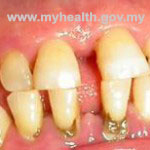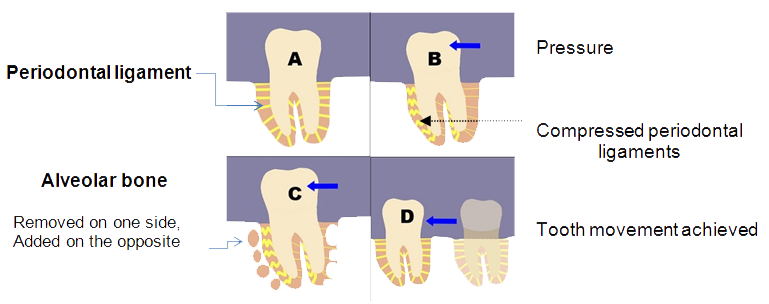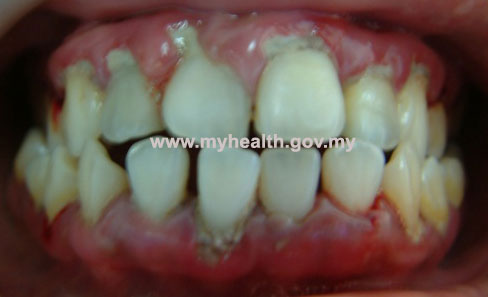
Orthodontics involves moving teeth through bone to relocate them in better places for both appearance and function. The outcome of orthodontic treatment is very much influenced by your periodontal (gum) status before, during and after treatment. Assessment for the presence of any form of gum disease before orthodontic treatment is wise to ensure that orthodontic treatment is done in a healthy mouth.
How does a tooth move during orthodontic treatment?(see diagram)
Your teeth are covered on top by gum tissue (also called gingiva). Underneath, the periodontal ligaments (gum fibers) embrace the root portion of the teeth, attaching them to the surrounding alveolar bone (the jaw bone that surrounds teeth).
When orthodontic braces put pressure on your tooth, the periodontal ligament stretches on one side and is compressed on the opposite. This process will loosen the tooth.
The process of moving teeth activates bone cells to remove bone in front of the moving tooth and lay new bone down behind it. The bone, then grow in to support its new position ( this is called bone remodeling). All of these occur due to the light forces being applied by the braces.
To enable this to happen successfully, the supporting structures of the teeth ( periodontium) consisting of the gingiva, periodontal ligaments and the surrounding bone, must be healthy. Before doing any tooth movement, there should be no inflammation (infection) in these structures.

Image taken from: http://www.dentalorg.com/biology-of-tooth-movement.html
A magnificent orthodontic treatment can be destroyed by poor periodontal support. Then again, the health of the periodontium which support the teeth may be affected by orthodontic tooth movement if periodontal disease already exists before orthodontic treatment.
Orthodontic treatment isn’t just about making your teeth look good. It’s about dental hygiene in general and that includes the health of your gums. Hence, evaluation and maintenance of periodontal health before, during and after treatment is very important.
What is periodontal (gum) disease?
Gum disease is inflammation (infection) of the supporting structures around your teeth.
Warning signs of gum disease include:

- Red, swollen or tender gums, bleed while brushing, flossing, or eating hard food,
- Gums that are receding or pulling away from the teeth, which make the teeth to look longer than before
- Pus coming out between your gums and teeth,
- Loose or separating teeth, persistent bad breath,
- A change in the fit of your dentures,
- A change in the way your teeth fit together when you bite.
If left untreated, periodontal (gum) disease can lead to bone loss around teeth. This is important to note, as orthodontic treatment in the presence of active periodontal disease may lead to accelerated and extensive bone loss.
This does not mean, however, that people who have had periodontal disease, treated and controlled, cannot undergo orthodontic treatment. In fact, sometimes it is desirable because it moves teeth to positions that are more cleansable.
Therefore, if you think you may have gum disease, visit your dentist who would be able to make a diagnosis of the problem and may recommend you see a gum specialist (periodontist) for treatment.
Before starting orthodontic treatment, it is advisable to ensure the periodontal disease is under control and certified by the dentist involved with treating this condition.
Those with periodontal (gum) disease undergoing orthodontic treatment must go through appropriate periodontal management. You must commit to an on-going periodontal maintenance to ensure that the disease does not recur throughout the process of the treatment.
Prior to treatment, the orthodontist will make sure that you are capable of performing adequate oral hygiene practice. Failure to comply with the required oral hygiene level, orthodontic treatment will be postponed until satisfactory plaque control is achieved.
During orthodontic treatment, the oral hygiene should be maintained at optimal level so that negative effects such as periodontal disease and dental caries can be minimized. This is important for successful orthodontic outcome.
In conclusion, every patient for whom orthodontic treatment is planned, requires a periodontal assessment. For younger patients this will be carried out by the patient’s dentist and orthodontist. In older patients, the assessment procedure is more likely to also involve a periodontist to assess the periodontal health. Oral hygiene is an important factor in successful orthodontic treatment. Negligence in maintaining good oral hygiene may have significant impact on orthodontic treatment results.
References
- Risk of orthodontic treatment, Australian Society of Orthodontists http://www.aso.org.au/docs/orthodontics/Risks.htm
- Orthodontic tooth movement, http://www.dentalorg.com/biology-of-tooth-movement.html
- Carranza’s Clinical Periodontology Expert Consult, 11th Edition, Michael G. Newman, DDS, Henry Takei, DDS, MS, Perry R. Klokkevold, DDS, MS and Fermin A. Carranza, Dr. ODONT
| Last Reviewed | : | 15 January 2016 |
| Writer | : | Dr. Rosrahimi bt. Abd Rahim |
| Accreditor | : | Dr. Norhani bt. Abd Rani |







